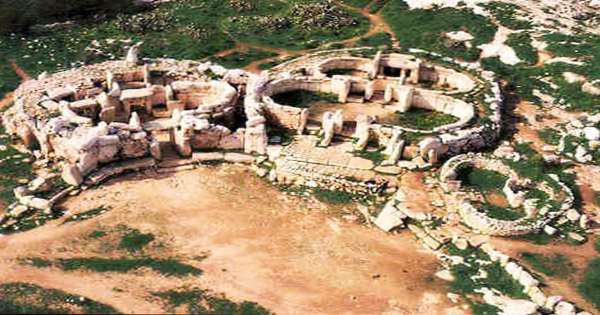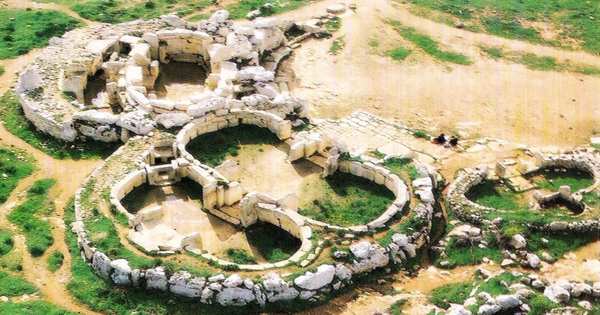Malta is home to the world’s oldest free-standing structures. The Megalithic Temples of Malta (Maltese: It-Tempji Megalitiċi ta’ Malta) are monumental prehistoric buildings built between the 4th century Bc and the 3rd millennium BC. Until Göbekli Tepe’s discovery, they had been claimed as the oldest free-standing structures on Earth. These megalithic complexes, archaeologists claim, are the product of local developments in a cultural evolution process. They rank among the world’s oldest free-standing stone buildings and are noteworthy for their shape and decoration diversity. Each complex is a unique masterpiece of architecture and a witness to an outstanding prehistoric culture renowned for its extraordinary achievements in architecture, art, and technology.
Malta is an island country in the Mediterranean Sea, about 50 miles (80 kilometers) south of Sicily and 176 miles (284 kilometers) east of Tunisia. Seven megalithic temples, each the product of individual creation, are located on the islands of Malta and Gozo. The temples of Hagar Qim, Mnajdra, and Tarxien on the island of Malta are unique architectural masterpieces, considering the minimal resources available to their constructors. The Ġgantija temples (two sites) were listed as a UNESCO World Heritage Site in 1980. The original listing was further expanded by the UNESCO Committee in 1992 to include five other megalithic temple sites. These are Ħaġar Qim (in Qrendi), Mnajdra (in Qrendi), Ta’ Ħaġrat Temples (in Mġarr), Skorba Temples (in Żebbiegħ), and Tarxien Temples (in Tarxien). Many tourists/visitors come to Malta to witness these magnificent temples, often constructed from coralline rock and calcareous globigerina.

(Megalithic Temples of Malta)
In plan, articulation, and construction technique, each monument is different. From an elliptical forecourt in front of a concave facade, they are normally approached. Heritage Malta currently operates the sites, while ownership of the surrounding lands varies from site to site. In addition to these, Malta has other megalithic temples that are not included in the list of UNESCO World Heritage Site. The façade and internal walls consist of horizontal blocks surmounted by upright stone slabs, known as orthostats. The horizontal masonry courses that survived suggest that the monuments had roofs corbelled, presumably capped by horizontal beams. This construction method was for its time, a remarkably sophisticated solution.
Many of the names used to refer to the various sites bear a similarity to the stones used for their construction. Usually, the exterior walls are formed in larger blocks that alternately face out and edge out, tightly tying the wall into the rest of the house. The room is filled with stones and earth between the exterior wall and the walls of the inner chambers, linking the entire structure together. From 5000 to 2200 BC, the temples were the result of many stages of building. There is evidence of human activity in the islands since the Early Neolithic Period (ca. 5000 BC); testified by pottery shards, charred remains of fires, and bones. With this proof of the older origins of the temples, a hypothesis that temple art was related to an Aegean-derived culture collapsed.
The entrance to the building is usually situated in the center of the façade, leading to a paved court through a monumental passageway. The interior of the buildings consists of semi-circular chambers, generally referred to as apses, arranged symmetrically on either side of the main axis. The first evidence of human habitation in the Neolithic occurred in the Għar Dalam phase, in c. 5000 BC. The time of the Temple, from c. The most notable monumental remains were created from 4100 BC to about 2500 BC. The builders of the temple used locally available stone, which they had a detailed understanding of. For exterior walls, they used rough coralline limestone and the softer globigerina calcareous for the more sheltered interiors and decorated elements.

- GGANTIJA (GOZO): This Templar complex, made up of two adjacent temples, is the oldest example of the archipelago’s megalithic temple, which dates back to the time between 3600 and 3000 BC and was founded before the famous Stonehenge. The site was cleared of debris from the soil in 1827 and remains incomplete without careful analysis. The loss resulting from this clearance was partly offset by the German artist Brochtorff, who, within a year or two of clearing the rubble, had painted the site. This is the clearance’s only realistic record.
- Ħaġar Qim: This temple of the copper age was constructed around 2700 BC, but in the first phase it was already undergoing different modifications. The facade of the temple is traditional, with an entrance to a trilithon, a bench, and orthostats. It has a wide forecourt with a retaining wall, from which the center of the building runs through a passage. The common, though considerably changed, Maltese megalithic design is followed by this entrance passage and first court. A separate entrance provides access to four separate enclosures, which replace the north-west apse and are independent of each other. Outside the temple, a monolith was perceived as a phallic worship icon that possibly lived in the temple.
- MNAJDRA: L-Imnajdra temples lie in a hollow 500 meters from Ħaġar Qim. In its own right, it is another dynamic site and it is centered on a near-circular forecourt. The best preserved of the three temples of Mnajdra, and interesting for the hidden rooms concealed in the thickness of the walls. And it is possible that a curative cult was practiced in this temple because there were representations of anatomical parts of the human terracotta body with signs of infirmity.
- Skorba: Skorba is an archaeological site found in Malta’s Mgarr, just a few kilometers from Ta Hagrat. The site is made up of prehistoric buildings that demonstrate the life of the Maltese Island’s first settlers. This monument has a typical three-apsed shape of the Ġgantija phase, of which the greater part of the first two apses and the whole of the façade have been destroyed to ground level. In the 1960s, these temples were excavated by David Trump, who found in the excavation the ruins of 2 megalithic temples, one of which was built around the same time as the Ggantija Temples (3,150-2,500 BC), and the other around the Tarxien Temples (3,600-3,200 BC).
- Ta’ Ħaġrat: The Ta’ Ħaġrat temple in Mġarr is on the eastern outskirts of the village, roughly one kilometer from the Ta’ Skorba temples. The remains consist of a double temple, both in the form of a trefoil, made up of two adjacent complexes. Both sections are less commonly planned and smaller in size than many of Malta’s other Neolithic temples, and no blocks are painted. In 1925–27, Sir Temi Ammit excavated the site. Many examples of what is now known as Mġarr phase pottery have been produced by a village on the site that pre-dates the temples by centuries.
- Tarxien: The first and oldest temples date back to 2200 BC, while the most recent temples date back to 400 years ago. The most monumental stone statue of the period was found inside these temples: originally a height of 2.50 m, this statue, which supposedly depicts a Mother Goddess, was broken into half and the section is now missing.
The key legislative instrument for preserving cultural heritage resources in Malta, the Cultural Heritage Act, applies to all six temples (2002). This Act provides for the conservation and management of cultural heritage resources by national bodies and governs them. Apart from those listed in the UNESCO World Heritage list, Malta has numerous other megalithic temples and related sites. Others were killed, such as Kordin I and II. The other temples typically consist of only a few scattered megaliths or remains, but some are in better condition, such as Buġibba Temple (which is now in the hotel grounds). For the inscribed land, which covers each temple and its buffer zone, a Management Plan was created.
Information Sources:















